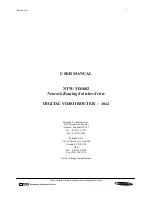
Revision: 0
6
Technical specifications are subject to be changed without notice
4. MIDI connection
Via the MIDI bus system several routers and control panels can be interconnected. The standard MIDI interface is used on all
Network MIDI control ports. For interconnection between the devices a standard MIDI cable with 5pin DIN connector on
both ends is used. The Network MIDI bus system allows connection of up to 16 routers with different addresses on the same
bus. Routers which are defined to work married e. g. 2 routers as Audio follow Video or 3 routers as RGB (YUV) must be set
on the same address. Control panels dedicated to work with a specific router must have the same address as the router.
Several panels can work together with one specific router. Up to 16 single routers or combinations of routers can be
controlled from one I-Control control screen. The MIDI bus system and all RS-232 ports interchange the system status.
4.1.
Several routers in one system
The Network MIDI bus system allows the interconnection of up to 16 routers with different addresses in one system. A
combination of routers working married counts as one address. This might for example be 1 audio 1 video router
working as an audio follow video system or 3 video routers working as a RGB (YUV) system. The routers in such a
constellation have to have the same address.
4.2. Connecting
control
panels
To get a control panel working with a specific router, give the control panel the same address as the router. Several panels
can be addressed to the same router. The X-Y panels can control 2 layers with breakaway function. If it is necessary to
control more layers with breakaway an additional panel must be used. Panels can also be connected to a router via the RS-
232 interface. Please refer to your control panel manual for installation.
4.3.
Pin-out and cable type
The pin-out of all Network MIDI ports follows the standard MIDI specification.
A 1 to 1 cable with 5pin DIN connector is used. The following pin-out is used:
1 - n.c.
1 - n.c.
2 - shield # # # # # # # # # # # # # # # # # # # # # # 2 - shield
3 - n.c.
3 - n.c.
4 - data - - - - - - - - - - - - - - - - - - - - - - - - - - - - - 4 - data data lines must
5 - data - - - - - - - - - - - - - - - - - - - - - - - - - - - - - 5 - data be twisted pair
The standard MIDI specification recommends the use of shielded twisted pair cable types for interconnection between the
units.
4.4.
MIDI bus structure
The Network MIDI bus structure follows the standard MIDI bus definition. The Network MIDI bus is defined as a closed
chain of units. This means that the MIDI OUT of the last unit must be connected to the MIDI IN of the first unit in the
MIDI chain. To avoid problems with the control of Network units the installer/user has to assure that the bus structure is
installed according to this definition. The total number of MIDI devices in a MIDI chain is limited to 50.














